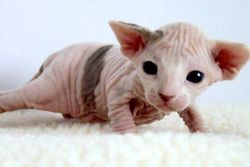•9:00 PM

In my lessons this afternoon, we discussed about animals, e.g, cats and dogs. We learned about the Greyhound dog which is very popular in racing. It can run as fast as 65kph. On the other hand, we learned about the Sphinx cat. It caught my attention because of its appearance.
I've seen the Sphynx or Sphinx in television only. Based on what I saw, the Sphynx is hairless and ugly. Because I'm interested to know more about it, I made a research in the internet prior to my lessons. And, this is what I found out....
The Sphynx (aka Canadian Hairless) is a rare breed of cat. The Sphynx appears to be a hairless cat, although it is not truly hairless. The skin should have the texture of chamois. It may be covered with very soft, fine down, which is almost imperceptible to both the eye and touch. On the ears, muzzle, tail, and feet, a short, soft, fine hair is allowed. Lack of coat makes the cat quite warm to the touch. Whiskers and eyebrows may be present, either whole or broken, or may be totally absent. Their skin is the color their fur would be, and all the usual cat marking patterns (solid, point, van, tabby, tortie, etc) may be found in Sphynx too. People are surprised by how different their personalities are. Many describe them as part monkey, pig and human because of how intelligent, extroverted and affectionate they are.
Sphynx cats are not maintenance-free. Their lack of hair results in increased body oils. Regular bathing is often necessary. Care should be taken to limit the Sphynx cat's exposure to outdoor sunlight at length, as they can develop a sunburn, similar to that of human exposure. In general, Sphynx cats should never be allowed outdoors unattended, as they have limited means to conserve body heat in colder temperatures, and their curious nature can take them into dangerous places or situations.
The Sphynx breed is known for a sturdy, heavy body (many cats of this breed also develop a pot belly), a wedge-shaped head, and an alert, friendly temperament. Although hairless cats have been reported throughout history (hairless cats seem to appear naturally about every 15 years or so), and breeders in Canada have been working on the Sphynx breed since the early 1960s, the current American and European Sphynx breed is descended from two lines of natural mutations:
- Dermis and Epidermis (1975) from the Pearsons of Wadena, MN, USA and
- Bambi, Punkie, and Paloma (1978) found in Toronto, ON, Canada and raised by Shirley Smith.










0 comments: